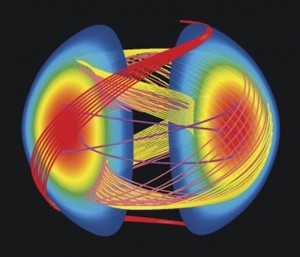
New imaging technique allows real-time 3D property mapping
University of Manchester researchers, working with colleagues in the UK, Europe, and the US, say a new imaging method—termed pair distribution function-computed tomography—enables real-time observation of in-situ chemical reactions, probing of stress-strain gradients in manufactured components, and other capabilities. According to one of the researchers, standard X-ray tomography works by collecting the transmitted beams, rotating the sample, and mathematically reconstructing a 3D image of the object. The new technique uses the scattered X-rays to obtain information about the structure and chemistry of objects with nanocrystalline structures, allowing users to build a detailed image of the object and separate the nanostructure signals from the different parts of a working device to see what atoms are doing in various locations.
Glass surface treatment completes One World Trade Center spire
EnduroShield glass surface treatment has been applied to the 408-foot, 758-ton spire of One World Trade Center, the primary building of the new World Trade Center complex in New York City. The two-molecule thick treatment was sprayed onto glass panels in the factory before the glass was installed onto the antenna’s steel frame structure. It chemically bonds to the glass substrate, providing a hydrophobic surface that resists staining and etching. The spire, which will be used as a broadcast antenna, brings the 104-story tower to its symbolic height of 1,776 feet, making One World Trade Center the tallest building in the Western Hemisphere and the third-tallest in the world by pinnacle height.
Simulation points to future solar direction
(American Institute of Physics) According to computer models developed by researchers at North Dakota State University and the University of South Dakota, the battle for the nanoscale energy-harvesting technology of future solar panels will play out between quantum dots and nanowires. The scientists used computational models to predict the electronic and optical properties of three types of nanoscale silicon structures with potential as solar energy collectors: a quantum dot, one-dimensional chains of quantum dots, and a nanowire. They found that arrays of amorphous quantum dots or merging them into a nanowire maximized light absorption efficiency. The researchers plan to continue the computational approach by building more realistic models, such as larger quantum dots with their surfaces covered by organic ligands, and by simulating the processes that occur in actual solar cells.
New from MIT, NASA: The neutron microscope
Researchers at MIT, working with partners at NASA, have developed a new concept for a microscope that would use neutrons instead of light or electrons to create high-resolution images. The scientists say neutron-based instruments can probe inside metal objects while in use to learn details of their internal structure in real time, among other capabilities. Until now, most neutron instruments have lacked the optical components to produce more than weak images with poor resolution. The new instrument uses several reflective cylinders nested inside each other to increase the surface area available for reflection for better neutron focusing. According to the researchers, the device could improve the performance of existing neutron imaging systems by a factor of about 50, allowing for much sharper images, much smaller instruments, or both.
Innovative concrete bridge to open this fall
Just east of Jefferson City, Mo., a bridge under construction will incorporate some spans made with an unusual concrete mix and be outfitted with various sensors and instrumentation to collect data on how well the bridge materials perform over time. The three-span structure is being built using high-strength self-consolidating concrete developed by researchers at Missouri University of Science and Technology that allows designers to either extend the span length of girders or reduce the number of girder lines needed in a given span by allowing for additional prestressing tendons that increase the girder’s load-carrying capacity. Scientists also expect the material to have reduced maintenance costs and an extended service life compared to conventional concrete. Embedded sensors will monitor the material, and other instrumentation will allow the research team to collect data during load testing and normal in-service conditions. One of the structure’s intermediate supports also will use portland cement with a high fly ash content.

